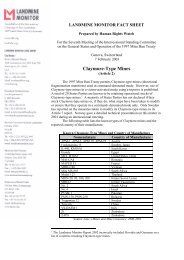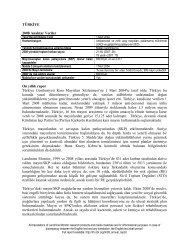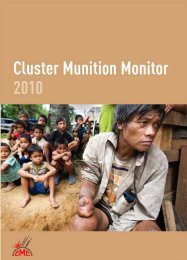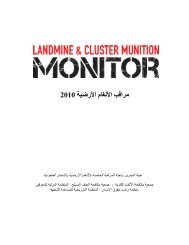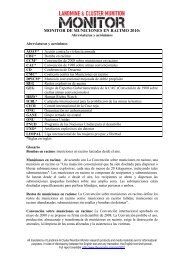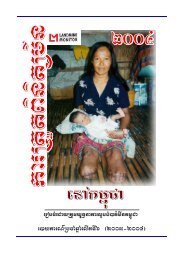Download PDF - Landmine and Cluster Munition Monitor
Download PDF - Landmine and Cluster Munition Monitor
Download PDF - Landmine and Cluster Munition Monitor
Create successful ePaper yourself
Turn your PDF publications into a flip-book with our unique Google optimized e-Paper software.
© Xavier Bourgois/HI, February 2011<br />
Funding Support<br />
Under Article 6 of the Convention on <strong>Cluster</strong> <strong>Munition</strong>s, each State Party “has the right to seek <strong>and</strong> receive assistance”<br />
to ensure implementation of the convention’s obligations, including those to destroy stockpiled cluster munitions within<br />
eight years, clear areas contaminated by cluster munition remnants within 10 years, <strong>and</strong> provide victim assistance. States<br />
Parties “in a position to do so” are obligated to provide technical, material, <strong>and</strong> financial assistance to implement these<br />
measures.<br />
From a survey of donor activities by 32 governments <strong>and</strong> the European Commission (EC), the <strong>Monitor</strong> has verified<br />
that 21 states <strong>and</strong> the EC reported supporting one or more of the following activities related to cluster munitions in 2011:<br />
clearance of cluster munition remnants, victim assistance, risk education, stockpile destruction, <strong>and</strong> advocacy in support<br />
of the Convention on <strong>Cluster</strong> <strong>Munition</strong>s. In 2011, these donors provided the equivalent of US$60 million to support<br />
these activities in 13 states contaminated by cluster munition remnants, including countries recognized as among the<br />
most affected by cluster munitions: Lao PDR, Lebanon, <strong>and</strong> Vietnam. 1 Previously, the <strong>Monitor</strong> recorded a total of $20.52<br />
million of support provided by 11 states <strong>and</strong> the EC in 2010.<br />
While more funding data was made available from a greater number of donor states in 2011 <strong>and</strong> the first half of 2012<br />
than in the past, this information must still be treated with caution; it is incomplete <strong>and</strong> clearly not a comprehensive<br />
accounting of resources devoted to the global effort to address the humanitarian problems caused by cluster munitions.<br />
Very few donor states disaggregate expenditure specifically for activities related to cluster munitions. 2 Some have<br />
reported funding for activities related to cluster munitions when the expenditure was ultimately used for clearance of<br />
mines or unexploded ordnance. 3 Victim assistance funding is also difficult to trace because the activities encompass<br />
multiple government agencies <strong>and</strong> programs that benefit people who are not cluster munition casualties. Limited data is<br />
available on stockpile destruction funding. (See stockpile destruction section below.)<br />
A communitybased<br />
UXO<br />
risk education<br />
session at<br />
a school in<br />
Soran, Iraq.<br />
1<br />
Australia response to <strong>Monitor</strong> questionnaire by Christine Pahlman, Mine Action Coordinator, AusAID, 24 April 2012; Austria response<br />
to <strong>Monitor</strong> questionnaire by Wolfgang Bányai, Unit for Arms Control <strong>and</strong> Disarmament in the framework of the UN, Federal Ministry for<br />
European <strong>and</strong> International Affairs, 1 March 2012; Belgium Convention on Conventional Weapons Amended Protocol II, Form E, 31 March<br />
2012, <strong>and</strong> Convention on <strong>Cluster</strong> <strong>Munition</strong>s Article 7 Report, Form I, 30 April 2012; Canada Mine Ban Treaty Article 7 Report, Form J,<br />
30 April 2012; Denmark response to <strong>Monitor</strong> questionnaire by Katrine Joensen, Head of Section, Security Policy Department, Ministry of<br />
Foreign Affairs, 1 May 2012; France Convention on <strong>Cluster</strong> <strong>Munition</strong>s Article 7 Report, Form I, 30 April 2012; Germany response to <strong>Monitor</strong><br />
questionnaire by Lt.-Col. Klaus Koppetsch, Desk Officer Mine Action, Federal Foreign Office, 20 April 2012; Irel<strong>and</strong> Convention on <strong>Cluster</strong><br />
<strong>Munition</strong>s Article 7 Report, Form I, 30 April 2012; Italy response to <strong>Monitor</strong> questionnaire by Aless<strong>and</strong>ro Pirrone, Emergency Response<br />
Desk Officer, Demining Advisor, Ministry of Foreign Affairs – Emergency Office, 21 March 2012; Japan Mine Ban Treaty Article 7, Form<br />
J, 12 May 2012; Luxembourg Response to <strong>Monitor</strong> questionnaire by Ministry of Foreign Affairs, 15 March 2012; Netherl<strong>and</strong>s Response<br />
to <strong>Monitor</strong> questionnaire by Douwe Buzeman, Policy Officer Security <strong>and</strong> Development, Peace Building <strong>and</strong> Stabilisation Unit, Ministry<br />
of Foreign Affairs, 16 April 2012; New Zeal<strong>and</strong> Convention on Conventional Weapons Amended Protocol II, Form B, 16 April 2012;<br />
Norway response to <strong>Monitor</strong> questionnaire by Ingunn Vatne, Senior Advisor, Department for Human Rights, Democracy <strong>and</strong> Humanitarian<br />
Assistance, Ministry of Foreign Affairs, 15 March 2012; Spain Convention on Conventional Weapons Article 7 Report, Form I, March 2012;<br />
Sweden Response to <strong>Monitor</strong> questionnaire by Maria Linderyd Linder, Deputy Director, Head of Section, Department for Disarmament <strong>and</strong><br />
Non-Proliferation, Ministry for Foreign Affairs, 24 April 2012; Switzerl<strong>and</strong> response to <strong>Monitor</strong> questionnaire by Claudia Moser, Section for<br />
Multilateral Peace Policy, Federal Department of Foreign Affairs, 19 June 2012; United Kingdom (UK) response to <strong>Monitor</strong> questionnaire<br />
by Hannah Binci, Security <strong>and</strong> Justice Team, Conflict, Humanitarian <strong>and</strong> Security Department, Department for International Development<br />
(DfID), 9 May 2012; telephone interview with Jamie Franklin, Representative to the Americas, Mines Advisory Group (MAG), Washington<br />
DC, 23 July 2012; <strong>and</strong> email from Claus Nielsen, Programme Manager, DanChurchAid (DCA), 23 July 2012.<br />
2<br />
Compared to 2010, more states responded to the <strong>Monitor</strong>’s funding questionnaire on their 2011 activities by specifying their support for cluster<br />
munitions-related projects. Denmark, Iran, Italy, Japan, South Korea, Luxembourg, the Netherl<strong>and</strong>s, Sweden, <strong>and</strong> Taiwan all responded for<br />
the first time. Yet the majority of reporting by donor states does not disaggregate cluster munitions, <strong>and</strong> not all funds that were designated for<br />
specific country activities were spent on cluster munitions-related projects. None of the 93 projects that were designated as providing support<br />
for cluster munitions-related activities in 2011 included “cluster munitions” in their title.<br />
3<br />
For example, clearance of cluster munition remnants is often undertaken within the same operations as l<strong>and</strong>mine clearance, battle area<br />
clearance, <strong>and</strong> explosive ordnance disposal.<br />
63



